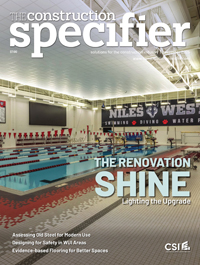Healthy Concrete Systems: Defending design intent
Ensuring design intent
How can someone be assured his or her design intentions are being met? The preference would be not to have to depend on subjective opinions that tend to differ among the perspectives of the owner, architect, and contractor. Instead, the goal is to clearly define quantifiably what is to be achieved as a contract requirement in the specifications. Not until the work has been tested and verified to have met specific requirements can it be determined to be acceptable.
A performance specification can avoid the visual inspection of what looks good at the time of substantial completion—only to wear off in a relatively short period, requiring costly reapplication of sealers.
Up until now, some of the concrete attributes mentioned in this article have been extremely difficult to achieve. An excellent concrete slab or polished concrete floor is the result of a skilled trade applying proper materials. Unless both are carefully identified in the contract documents, one will most likely come upon unsatisfactory results that do not meet expectations. Unfortunately, it has been all too often that at the very end of construction, with extreme pressure for impending occupancy, the owner is forced into accepting results neither expected nor desired. This is a tough pill to swallow when money is being exchanged for dissatisfaction just to get occupancy of the facility on time. Even less palatable is the ongoing additional expense that will be incurred to maintain a non-sustainable floor over the life of the building.
In order to avoid this dismal picture, it is extremely important to take all the following steps throughout the construction process:
- The owner team must clearly understand the design intent that is attainable and can be achieved in order to protect their dollar investment.
- The design team must understand what is achievable and confirm the design intent with the client. The team must document all the requirements in the construction documents and defend the design intent throughout the entire construction process. One should beware product substitutions that claim to be the same as what is specified. Shop drawing reviews are critical to verify design intent will be met.
- The construction team must be aware of the desired outcome of the documented design intent. This includes third-party qualified subcontractors that are certified and capable of producing the specified requirements. This must be confirmed during contract procurement phase to avoid the all-too common confrontation that occurs when it was overlooked and not included in the contract sum.
- Finally, the supplier team must be responsible for supplying the products and materials that are capable of achieving the intended design. Again, all too often, some suppliers will try to suggest their products are the same or better than what was chosen and specified based on performance, not just appearance. Substitutions must only be considered when they have specific test results showing proven performance capabilities satisfying the specified requirements.
Conclusion
Polished concrete has recently become a very popular design choice among interior designers due to its sustainable qualities and long-lasting aesthetic. While polished concrete is more expensive than applied coverings in terms of first costs, it may be one of the most economical choices over the life of a building. It is important the entire project team has a clear understanding of what is meant by ‘polished concrete,’ and then take the necessary steps to ensure the design intent is being met.
In some ways, construction professionals are the parents and guardians of their offspring (that is, the buildings they create). To this day, we cherish some of the ancient concrete structures built by the Roman Empire and have survived millennia. It is time again to make outstanding achievements in construction that will endure as economically viable, sustainable structures with durable, long-lasting, useful lives.
Bill DuBois, CSI, CCS, AIA, is the vice president of specifications with Tao Group LLC, a firm that assists building teams to achieve concrete installations meeting project expectations. He has 30 years of specification experience at major architectural firms and has recently chosen to pursue the next step of his architectural career at elevating a segment of the construction industry that has been an architectural specifier’s challenge. DuBois can be reached at bill_dubois@taogroupsolutions.com.
Chris Bennett, CSI, Assoc. AIA, is the vice president of business development at Tao Group. He is also involved with facilitating the popular construction education series, Praxis Live Events. Bennett previously led specifications efforts at Husqvarna Construction Products, and served as a Mandarin Chinese cryptolinguist on active duty for the United States Navy. He can be contacted at christopher.bennett@taogroupsolutions.com.








